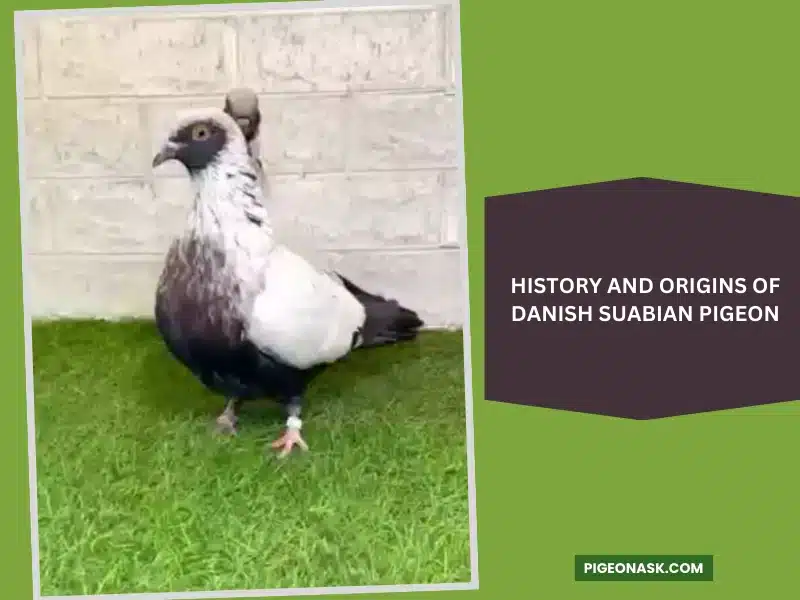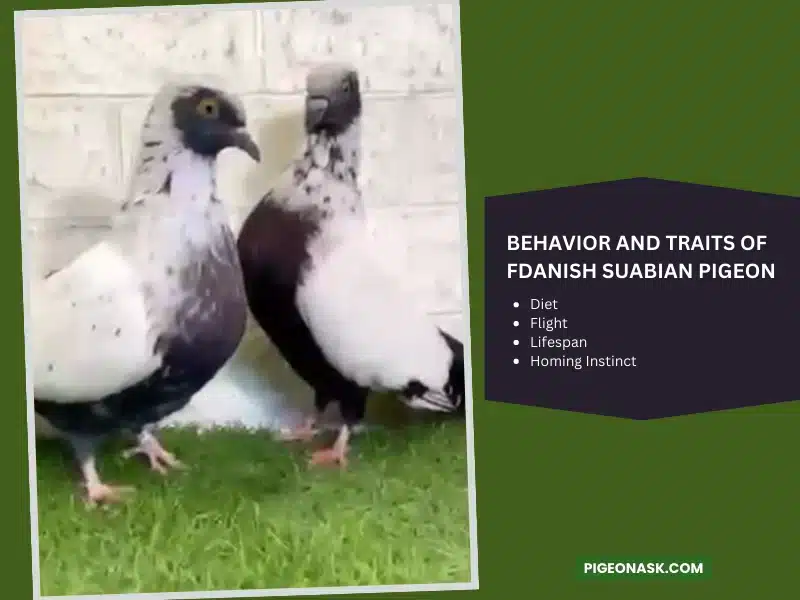Danish Suabian Pigeon: Breed Guide (With Infographic)
The Danish Suabian pigeon is a domestic pigeon primarily bred for show or decorative purposes.
However, the pigeon can be more than that. If treated correctly, good Danish Suabian pigeons can become great pets at home. They are gentle and docile animals that make for great companions at home.
In this article, you will learn all about this breed of pigeon and everything you need to do to breed them successfully. Stick around as we unravel the mysteries of one of the fanciest breeds of pigeons.
Danish Suabian Pigeon Profile
| Name | Danish Suabian Pigeon |
|---|---|
| Scientific Name | Columbia livia |
| Common Names | Pheasant Pigeon |
| Origin | France and Netherlands |
| Size | Medium |
| Weight | 350 – 380 grams |
| Lifespan | Up to 15 years |
| Physical Features | Intense colors, finch marks, neck ring, orange eyes, and black beaks |
| Behavior & Temperament | Social, docile, and calm |
| Breeding and Maintenance | Easy to breed and maintain |
| Common or Popular Varieties | Popular color variations in black, brown, yellow, and gray Head marking |
Overview
The Danish Suabian pigeon is a beautiful bird that can fly decently and be a good pet, but its primary purpose is exhibition. This breed of pigeons has a captivating color palette and upright posture that make it stand out.
While the name is Danish Suabian, another common name for the pigeons is Pheasant pigeon. This is because the color patterns are similar to the Silver Pheasant.
Looking for more articles about pigeons breed:
History and Origins of Danish Suabian Pigeons
The Danish Suabian pigeon is the result of many years of selective breeding, and its origin place is France and the Netherlands.

Initially, breeders used the Starling to develop the laced and then imported it to Denmark in approximately 1840.
Originally, the goal was to replicate the white color of the milky wings. And to achieve this purpose, the pigeon went through different crossings, like with the Oriental Frill.
We have covered an in-depth article on “Color pigeons“; if interested, you can check this article here.
Physical Characteristics and Features
The Danish Suabian pigeon has unique characteristics easily recognizable on their bodies. Here’s how you can identify these pigeons.

Appearance and Unique Features
A Danish Suabian pigeon has intense colors, finch marks, and a neck ring as some of its most captivating features. The eyes are orange, and the beaks are black and resemble those of field pigeons.
The pigeon has a back that slopes downward, covered with lengthy wings. These wings are white, with a lace design unique to the breed. As for the tail, it’s barless and black, a color similar to the rump.
Size, Weight and Body Structure
Danish Suabian pigeons are small pigeons, and their body structure can vary. For instance, some have peak-crested, shell-crested, or plain-headed heads. On the other hand, they have a closed tail of medium size.
The Danish Suabian pigeon usually weighs between 350 and 380 grams. This is the ideal weight, as it offers the perfect balance, and the birds are not too small or too big. Typically, the bird reaches this weight range once it’s mature.
Some Common Variations in Colors and Markings Across Different Species
The most popular varieties of Danish Suabian pigeons are brown, black, yellow, and gray.
Other than different colors, these birds have a unique trait, which is the head marking. This characteristic is the result of the main color passing from the wattle to the beak, passing over and behind the eye.
Behavior and Traits of Danish Suabian Pigeons
A Danish Suabian pigeon is usually a calm and docile bird. The bird enjoys socializing, meaning that it feels most comfortable in groups.

These pigeons are tolerant of humans and can be intelligent. When the bird likes something such as peanuts, it will find ways to let you know it wants more.
Diet
The Danish Suabian pigeon does not need a strict diet. Therefore, you can feed them what other pigeons usually have.
Create a diet with a seed mix, grains, and seeds. Other additions can be wheat and corn. Similarly, you can feed your Danish Suabian pigeons with vegetables, nuts, peas, and berries.
Flight
The flying ability of the Danish Suabian pigeon is above average, making them decent flyers. Nonetheless, this breed of pigeons is not suitable for racing purposes, and breeders don’t raise them for that purpose.
Lifespan
Generally, this breed of pigeons can live approximately ten years. However, some birds can live up to 15 years with proper care and attention.
Homing Instinct
The Danish Suabian pigeon does not have a strong homing instinct. While flying outside, they may only return if the distance traveled is not too far from home.
Breeding and Maintenance
The type of color you want your pigeon to be will heavily dictate how the breeding goes.
For example, if you want silver, you don’t want a breeding pair that are too blue or too black in the ground color. This is usually a flaw.
A similar scenario occurs with black pigeons. While evaluating them before getting a pair, avoid those with flecked body color and issues like failing in the green sheen.

Ideally, you must evaluate the body form, then the design of the markings, and then the main and secondary colors. The last few points of evaluation should be the color of the eyes and beak.
Ultimately, you must ask the seller for a matching pair capable of producing offspring of your preference.
If you don’t care about the color, you could choose the pair yourself.
Overall, the breeding process of these pigeons is similar to others. The male will court the female, and the female will lay two eggs. This incubation period takes between 18 and 19 days.
Some Tips and Considerations for Successful Breeding. The following tips can help you breed Danish Suabian pigeons with more success and better results.
Find Reputable Sellers Before Buying a Pair
Make sure you get your pigeons from a reputable source to avoid flawed birds, and you only get high-quality ones.
Ask the seller if the pigeon you choose is more suitable as a pet or for actual show purposes based on its quality.
Choose Healthy Birds and Perform Routine Checks
If you notice flaws or health issues, act quickly. When one pigeon is beyond help, it will be best to discard it.
Assign a Specific Space for the Breeding Pair
Separate the birds if you notice aggressions during the breeding session by placing the female and male in a separate location.
Evaluate the Eggs
Make sure the eggs are good and remove any unfertilized eggs.
Feeding and Housing Requirements
Feeding Danish Suabian pigeons is a relatively easy task.
First, you need to make sure the diet has a good balance of rich nutrients and vitamins to help them grow healthy. Then, you must ensure there’s enough grit and stomach gravel.
Clean, fresh water is equally important, and it should be available for pigeons throughout the day.
Likewise, you will need to provide food three times per day for the little ones and two times per day for the adult pigeons.
Keeping a regular feeding schedule is crucial. If you’re not at home during the day, feed the birds first thing in the morning. Then, provide a little more food at the end of the day.
Just make sure there’s still sunlight when you feed them.
Housing Requirements
The housing for Danish Suabian pigeons must be durable, resistant, and safe. So, a cage made with stainless steel could be the perfect place for the pigeons.
This cage must be in a ventilated area with access to sunlight but not exposed to it.
Likewise, the housing must be spacious enough to let the birds open their wings and walk for exercise. As a bonus, adding toys to the bird housing may help keep them entertained.
Creating the right conditions to make the birds feel comfortable is essential to keep them relaxed and happy.
Final Words
A Danish Suabian pigeon is one of the easiest breeds to raise at home. For this reason, we consider this type of bird the ideal choice if you’re just getting started in this world.
And if you already have some experience, then breeding and raising these pigeons will be even easier.
Did you like all these fascinating details about the Danish Suabian pigeons? Then don’t forget to follow us on Facebook, Twitter, and Pinterest. We constantly put out more interesting details and information about the bird world and so much more!
Image Credits:
- Canva.com/photos
- Twitter.com/ (deadbirdprince)
- Youtube.com (pigeonsaddiction)
